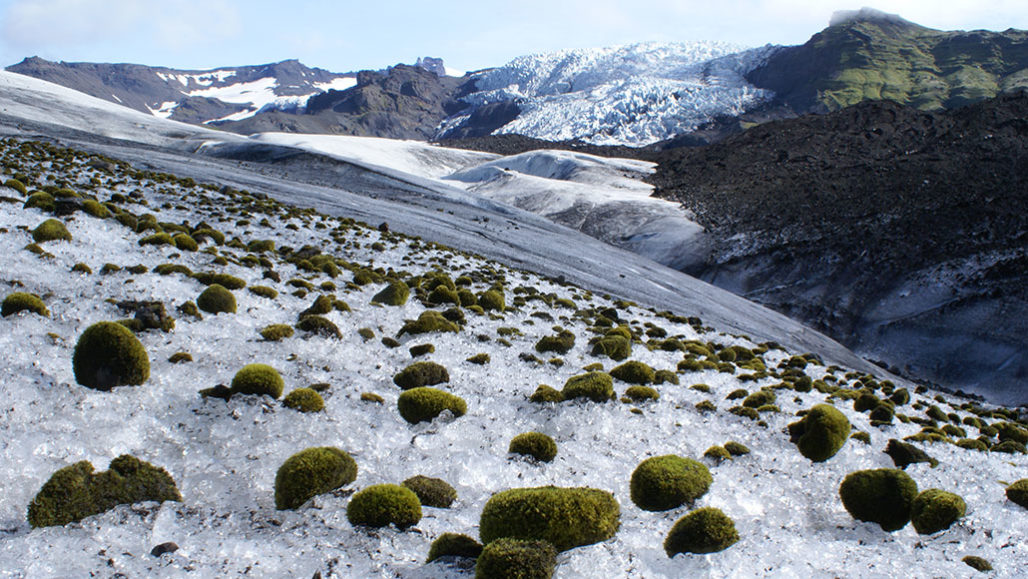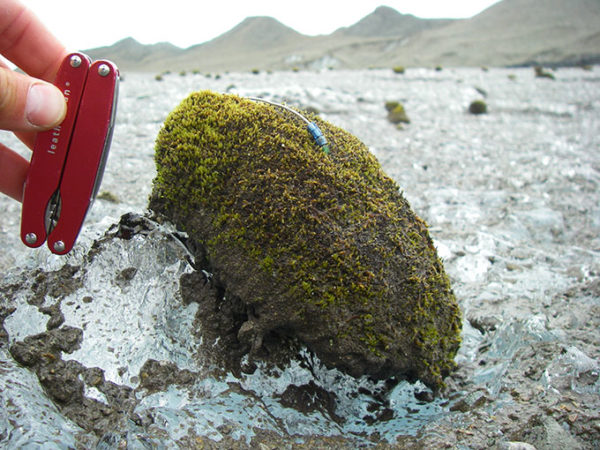On an Alaskan glacier, little green moss balls roll in herds
Nicknamed ‘glacier mice,’ they appear to move together, though it’s not clear how

This herd of moss balls, nicknamed “glacier mice,” is located atop the Virkisjökull Glacier in Iceland. In Alaska, the peculiar herdlike motion of these moss balls across the ice has mystified scientists.
Darrel Swift
By Beth Geiger
What’s fuzzy, lives on a glacier and migrates but isn’t an animal? Answer: Oval balls of moss, nicknamed “glacier mice.” Such moss balls can be found scattered across a few of the world’s glaciers in places such as Iceland and Alaska. Now, in a surprise finding, scientists have discovered that the moss balls move across the ice together, like a herd. The question remains: Why?
Glacier scientist Tim Bartholomaus and wildlife biologist Sophie Gilbert both work at the University of Idaho in Moscow. They had seen the moss balls on visits to the Root Glacier in southeast Alaska. The potato-shaped moss clumps seemed to move across the ice. To learn more about what was happening, they teamed up with glacial biologist Scott Hotaling at Washington State University in Pullman.
Only a few other scientists have studied such moss balls. Most suspect the balls form when airborne moss spores gain a foothold on a small rock or similar debris. Over time, the growing moss forms an oval ball. Entire communities of tiny creatures develop and thrive inside these tangled balls of greenery.
But there were still many questions about the moss balls. Bartholomaus, Gilbert and Hotaling were curious about how quickly the glacier mice traveled. And they wanted to know what might guide their movement. They also wondered how long the moss balls survive on a glacier’s surface. In summer 2009, the team went back to the Root Glacier.
The trio borrowed a strategy usually used for tracking animals. “It’s called ‘mark and recapture,’” says Bartholomaus. They tagged 30 balls with bracelets that had distinctive patterns of colored beads. Then the researchers returned over six summers to check back on the tagged moss balls. Each year, they also placed markers on the moving glacier surface as reference points. Then they measured and recorded the position of each moss ball over several weeks.

The first surprise: Year after year, they “recaptured” at least 18 of the tagged moss balls. That shows that moss balls can survive intact for six years or more. This important finding highlights the unexpected ecosystems found on some glaciers, says Nicholas Midgley. He studies glaciers at Nottingham Trent University in England. Midgley has studied glacier mice in Iceland but was not involved in this study. “It’s really interesting to see that they persist so long,” he says.

Educators and Parents, Sign Up for The Cheat Sheet
Weekly updates to help you use Science News Explores in the learning environment
Thank you for signing up!
There was a problem signing you up.
Mice on the move
An even bigger surprise came when the researchers tracked the balls’ paths. Moss balls tumble and move because of the sun. In summer, the sun’s heat melts down the Root Glacier around 7.5 centimeters (3 inches) each day, Bartholomaus says. Each moss ball acts like a tiny umbrella, shading the ice beneath it. As the glacier melts around a ball, it ends up perched atop a pedestal of ice. Within a day or two, the pedestals get to be as high as 5 to 7.5 centimeters (2 to 3 inches) tall. “At that point, the moss ball tips off,” says Bartholomaus. That rolling helps the moss ball survive, notes Midgley. It exposes the moss on the bottom to life-sustaining sunlight.
This continuous cycle of tipping and flipping moves the moss balls across the glacier an average of about 2.5 centimeters (1 inch) per day in summer. But the researchers noted something odd about the movement. The moss balls didn’t roll randomly. Instead, groups of moss balls aligned and moved together, like a herd. “When I plotted the motion and they were all moving together, it was mind-boggling,” recalls Bartholomaus.
“They even change direction together,” adds Hotaling. But they don’t pile up like windblown tumbleweeds. They keep their distance from each other even as they move in sync.
The team tested and analyzed several possible reasons for the coordinated moss motion. But none seemed to explain it. The moss balls didn’t roll with the wind. They didn’t follow the direction of melt from the sun. Nor did they go with the ice flow. “They didn’t even move in the downhill direction, as you might expect,” says Hotaling. The trio published its findings June 6 in Polar Biology.
Bartholomaus suspects glacial melt may play some role. And perhaps, says Hotaling, the moss balls share some subtle shape that guides their travel. For example, maybe they are all just slightly wider at one end than the other, like chicken drumsticks. “If you roll a chicken drumstick across the counter, it would spin,” he points out. The team would also like to set up a camera to track patterns of the balls’ movement over time, Hotaling says. To explore these ideas, though, will take more fieldwork. Until then, it remains a mousy mossy mystery.







